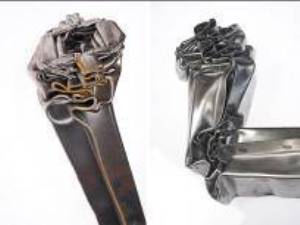Nov 2 2012
Within the automotive industry, lightweight construction offers a solution to the development of more economical and more ecologically viable vehicles. The more steel components that are replaced by lighter materials such as aluminum, the lower is the weight reduction achieved and the greater is the saving in both fuel consumption and emissions. Drive performance also improves.
 Crash tests illustrate how much of the impact energy is absorbed by deformation of the adhesive-bonded joint. (Photo: Business Wire)
Crash tests illustrate how much of the impact energy is absorbed by deformation of the adhesive-bonded joint. (Photo: Business Wire)
Henkel develops adhesives that facilitate the permanent bonding of different, lighter materials where these cannot be thermally welded. In addition, the company manufactures surface treatment products and systems offering the best possible results with sparing chemical input. These technologies cut production costs by facilitating a reduction in the consumption of materials while at the same time protecting the health of employees working in the sections concerned.
There is pressure on the automotive industry to manufacture light vehicles offering low fuel consumption values so as to reduce environmental burden. This represents a challenge for vehicle designers. One approach is to create the car body by pretreating and joining together components of lighter, albeit disparate materials. Henkel, world market leader in adhesives, sealants and surface treatment solutions, is permanently engaged in the further development of its products and technologies in order, for example, to reduce the production costs and the material consumption levels of automobile manufacturers, and/or to create a safe working environment. For the driver, there are also safety advantages to be had from adhesive-bonded joints, as these absorb a significant portion of the impact energy generated in an automobile crash.
Loctite enables lightweight construction of fast cars
A lightweight construction such as implemented in the case of the Porsche 911 GT3 Cup racing cars is facilitated through the use of alternative materials such as aluminum and composites. Composites based on carbon or glass fiber are becoming increasingly important for modern high-performance applications, due in particular to their ability to offer low weight combined with high strength.
In the case of mass-produced cars especially, injection processes such as resin transfer molding are widely used. For this, Henkel has developed a polyurethane-based composite matrix resin characterized by its short curing time and ease of use. New Loctite MAX2 not only cures significantly faster than standard epoxy resins, during injection its lower viscosity also enables more efficient, gentler impregnation of the fibers. The material produced, less brittle and characterized by its improved tear strength, makes an important contribution to ensuring that composites can be mass-produced with good cost efficiency and process reliability.
Adhesive bonding for better crash test results
An automobile assembled using extensive adhesive bonding produces better crash test results than a car that has been riveted or welded. “Because the bonded joint can deform in the event of impact, a portion of the crash energy is absorbed by that deformation work,” explains Dr. Stefan Kreiling, Head of Product Development Automotive Europe at Henkel. The adhesive bonds employed in the body assembly exhibit a number of advantages: Adhesives increase the stiffness of the automobile, seal joint seams, reduce the number of welds and render cars more corrosion resistant. In addition, the specialty adhesives used in body construction and final assembly also help to reduce noise.
Environmentally compatible corrosion protection in two stages
Henkel has developed a two-stage process for the pretreatment of mixed bodies. In this split approach, a phosphate layer is no longer formed on the aluminum, while the steel and the galvanized steel are conventionally phosphated. By dividing the conversion treatment into two stages, the aluminum undergoes optimum preparation, but only in the second stage, that of post-passivation, through the formation of a zirconium-based conversion layer. This process ensures high-quality corrosion resistance combined with very good paint adhesion.
Continuous further development has ensured ongoing optimization of the pretreatment process in both qualitative and ecological terms: The reduction in the amount of energy consumed and chemicals used, such as fluoride or, in a subsequent revision, nitrite, helps automobile manufacturers to adopt sustainable manufacturing methods. Through the elimination of nitrite, there is no occurrence of nitrogen oxide emissions, something that also significantly improves occupational health and safety. Similarly, the wastewater no longer needs to be detoxified during the process. And the substantial reduction in phosphate sludge volumes exerts a positive effect on the waste footprint as well as reducing the cost of disposal and process plant cleaning.